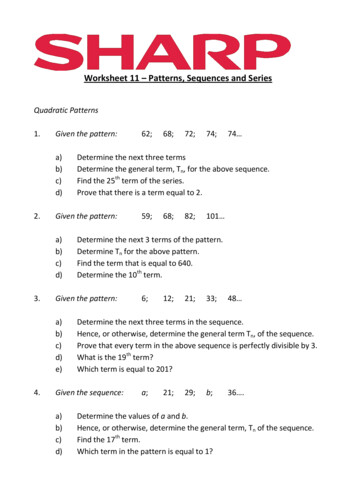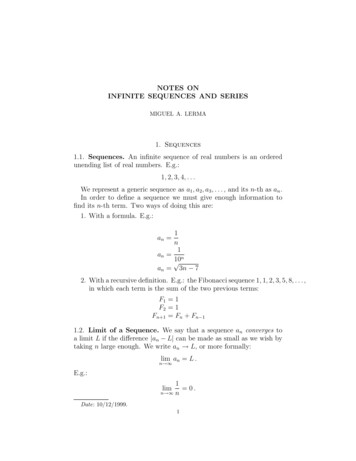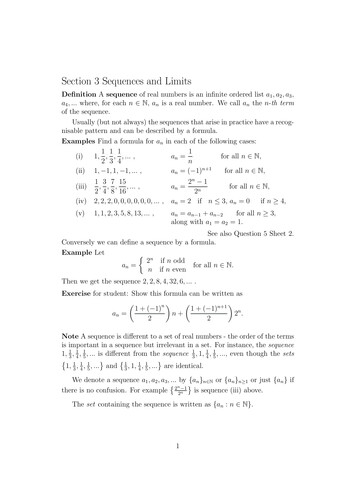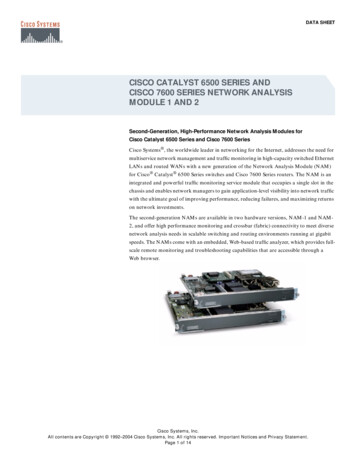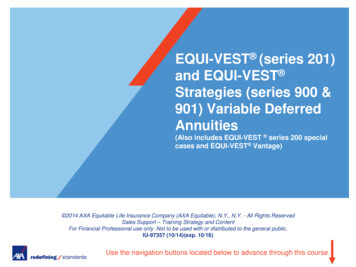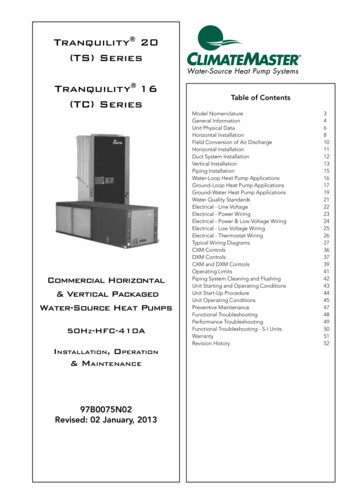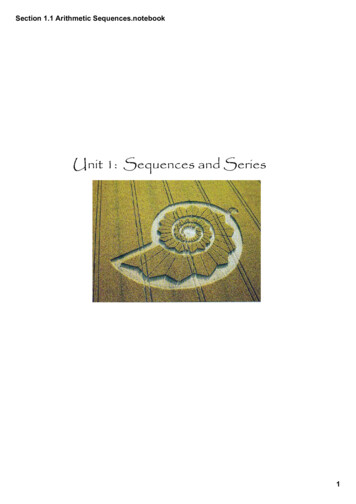
Transcription
Section 1.1 Arithmetic Sequences.notebookUnit 1: Sequences and Series1
Section 1.1 Arithmetic Sequences.notebookSection 1.1:Section 1.1:Arithmetic SequencesPages 6 21sequence an ordered list of objects.Examples :1, 2, 3, 4, 5,.2, 4, 6, 8, .10, 5, 0, 5, .2, 4, 8, 16, .1, 1, 2, 3, 5, 8, 13, .finite sequence a sequence that ends at a specific term.infinite sequence a sequence that does not end; has an infinitenumber of terms.2
Section 1.1 Arithmetic Sequences.notebookSequence Notation:t1 represents the first term of the sequence (sometimes represented as a)n represents the number of terms in a sequence or series.tn represents the general term of a sequence. Its value depends on the valueof n.Examples:2, 5, 8, 11, 14 a finite sequence t1 2 t5 145, 10, 15, 20, ., 100 a finite sequence t1 5 t3 155, 10, 15, 20, . an infinite sequence t1 5 t4 203
Section 1.1 Arithmetic Sequences.notebookArithmetic Sequence is an ordered list of terms in which thedifference between the consecutive terms is constant.Ex:common difference (d) the same value or variable that is added toeach term to create the next term.Ex:general term (tn) the formula that is used to find any value of asequence.4
Section 1.1 Arithmetic Sequences.notebookChart Page 9:Termst1t2t3t4Sequence10162228Sequence ExpressedUsing First Term andCommon Difference1010 610 6 610 6 6 6General Sequencet1t1 dt1 d dt1 2dt1 d d dt1 3d5
Section 1.1 Arithmetic Sequences.notebookGenerally:The general term of an arithmetic sequence is:tn t1 (n 1)dwhere:t1 is the first termn is the number of termsd is the common differencetn is the general term or the nth termSo, for the example on page 9, the general term would be:tn t1 (n 1)dtn 10 (n 1)6tn 10 6n 6tn 4 6n6
Section 1.1 Arithmetic Sequences.notebookMore examples:1. Determine the next four terms in the sequence 5, 2, 1 . Write the general termor the rule for this sequence.2. Find the first term in the arithmetic sequence for which t19 42 and d 4.3. Find the 47th term in the sequence 4, 1, 2, 5, .7
Section 1.1 Arithmetic Sequences.notebook4. Determine the number of terms (the position of 30) in the sequence 40, 38, 36, , . 30.5. In an arithmetic sequence, t 12 52 and t 22 102. Find the first three terms of thesequence and a general formula for tn .8
Section 1.1 Arithmetic Sequences.notebookExample 1 Page 10Determine a Particular TermA visual and performing arts group wants to hire a community events leader. Theperson will be paid 12 for the first hour of work, 19 for two hours of work, 26 forthree hours of work, and so on.a) Write the general term that you could use to determine the pay for any number ofhours worked.b) What will the person be paid for 6 hours work?9
Section 1.1 Arithmetic Sequences.notebookExample 1: Your TurnPage 11AnswerMany factors affect the growth of a child. Medical and health officialsencourage parents to keep track of their child’s growth. The generalguideline for the growth in height of a child between the ages of 3 yearsand 10 years is an average increase of 5 cm per year. Suppose a child was70 cm tall at age 3.a) Write the general term that you could use to estimate what the child’sheight will be at any age between 3 and 10.b) How tall is the child expected to be at age 10?a) tn n isb) 1010
Section 1.1 Arithmetic Sequences.notebookExample 2 Page 12Determine the Number of TermsThe musk ox and the caribou of northern Canada are hoofed mammals thatsurvived the Pleistocene Era, which ended 10 000 years ago. In 1955, the BanksIsland musk ox population was approximately 9250 animals. Suppose that insubsequent years, the growth of the musk ox population generated an arithmeticsequence, in which the number of musk ox increased by approximately1650 each year. How many years would it take for the musk ox population to reach100 000?11
Section 1.1 Arithmetic Sequences.notebookCarpenter ants are large, usually black ants that make their colonies inwood. Although often considered to be pests around the home, carpenterants play a significant role in a forested ecosystem. Carpenter ants beginwith a parent colony. When this colony is well established, they formsatellite colonies consisting of only the workers. An established colonymay have as many as 3000 ants. Suppose that the growth of the colonyproduces an arithmetic sequence in which the number of ants increasesby approximately 80 ants each month. Beginning with 40 ants, howmany months would it take for the ant population to reach 3000?AnswerExample 2: Your TurnPage 1212
Section 1.1 Arithmetic Sequences.notebookExample 3 Page 13Determine t1,tn, and nJonathon has a part time job at the local grocery store. He has been asked to createa display of cereal boxes. The top six rows of his display are shown. The numbers ofboxes in the rows produce an arithmetic sequence. There are 16 boxes in the thirdrow from the bottom, and 6 boxes in the eighth row from the bottom.a﴿ How many boxes are in the bottom row?b﴿ Determine the general term, tn, for the sequence.c﴿ What is the number of rows of boxes in his display?13
Section 1.1 Arithmetic Sequences.notebookExample 3: Your TurnPage 14AnswerJonathon has been given the job of stacking cans in asimilar design to that of the cereal boxes. The numbers ofcans in the rows produces an arithmetic sequence. Thetop three rows are shown. There are 14 cans in the 8throw from the bottom and 10 cans in the 12th row from thebottom. Determine t1, d, and tn for the arithmetic sequence.14
Section 1.1 Arithmetic Sequences.notebookExample 4 Page 14Generate a SequenceA furnace technician charges 65 for making a house call, plus 42 perhour or portion of an hour.a﴿ Generate the possible charges ﴾excluding parts﴿ for the first 4 h oftime.b﴿ What is the charge for 10 h of time?a)15
Section 1.1 Arithmetic Sequences.notebookb)16
Section 1.1 Arithmetic Sequences.notebookExample 4: Your TurnPage 15AnswerWhat is the charge for 10 h if the furnace technician charges 45 for thehouse call plus 46 per hour?17
Section 1.1 Arithmetic Sequences.notebookPage 1818
Jun 01, 2015 · Section 1.1 Arithmetic Sequences.notebook 3 Sequence Notation: t1 represents the first term of the sequence (sometimes represented as a) n represents the number of terms in a sequence or series. tn represents the g
